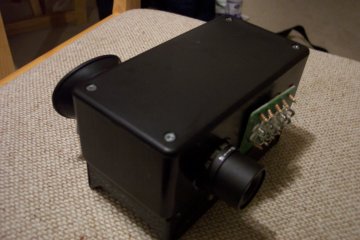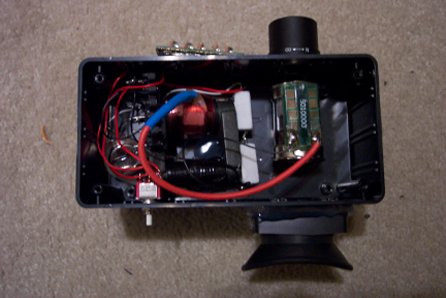Infrared Viewer

Email: sixmhz@yahoo.com
Link to my Homepage
Introduction
Here I made an infrared viewer (night vision scope) from mostly crap out of the trash. I did have to buy the main component, the image intensifier tube, because I think it's pretty unlikely that I'll come across one in the dumper.
Image Intensifier Tube
The backbone of this project is an infrared image intensifier tube. Itís just a vacuum tube about 2 inches in length and an inch in diameter. On one end itís got a screen that absorbs infrared light and emits electrons from the other side with the aid of a negatively biased high voltage electric field. The emitted electrons are then accelerated in vacuum towards the phosphorescent screen. As the electrons strike the phosphorescent screen, visible light is emitted from the opposite side of the screen forming the green and black image. Itís just like a small TV screen, except the infrared detector replaces the cathode. There are many kinds of intensifier tubes out there, each with their own advantages and disadvantages. The tube I chose for this project was whichever was the best deal on ebay. Not sure of the manufacturer, but the model number is 7118 and the box is stamped with the date 6/71. Yeah, itís pretty darn old but still works ok. It's a zero generation model, meaning that you really need extra IR illumination to be able to see anything through it. I paid $27 dollars for it and I saw several others for about that price. This particular tube also has an eight-stage full-wave voltage multiplier built right in, which makes powering this guy a breeze. The only electrical requirements it has is approximately 3 kV AC into the multiplier assembly where it is brought up to about -20 kV DC (estimated) to accelerate the electrons. Unfortunately, I canít quite measure the exact voltage output of the cascade because it produces less current than my kV meter drains when measuring the voltage.
Power Supply
The 3 kV AC for the intensifier tube is supplied by an old-school flyback transformer that I pulled from a really old computer monitor I found in the trash. I use the same single transistor driver circuit that is on my flyback transformer page to drive it. Most intensifier tubes will not have the voltage multiplier built into them, so they would require a DC voltage source. A modern-day flyback transformer should do the trick for most of them depending on their specific voltage requirements, or you could use an old AC flyback and build a voltage multiplier. Oh- and donít forget about good high voltage hygiene! This thing is going to be pressed against your face so do a good job on the insulation. Mine deals out a real nice shock if you touch the front lens, like, when you put on the lens cap-ouch!
Optics
The optics for the infrared viewer are pretty simple and straight forward. An hour or two with the optics section of your favorite physics book should get you by. Youíll need a convex lens in front of the tube to project an image onto the tube screen. At the ass-end of the tube, youíll need a simple magnifier (like for looking at stamps) maybe x10 magnification to make the image more viewable. I found a 8mm focal length CCTV lens new in the box while dumper diving (how fortunate!) This is what I use for the objective lens in the front, it even has a built in focus. For the magnifier/eyepiece, I pulled the optics from a Panasonic Color TV camera carcass that I bought from a place called "The Surplus Shed" for $5 bucks.
Infrared Illumination
To throw some more light on the scene, I bought a bunch of infrared LEDís from a surplus electronics site at 3 for a buck. I wired up ten of them and glued them to the front of the viewer box. You could also use a regular television or vcr remote control as a flashlight. Here is a photo of my scope's guts and also a fairly crappy photo of some stuff on my desk, through the viewer.


DISCLAIMER
The author assumes no liability for any incidental, consequential
or other liability from the use of this information. All risks and
damages, incidental or otherwise arising from the use or misuse of the information contained herein are entirely the responsibility of the user, have a nice day!
Last updated: 05/07/03
Copyright 2003, Greg Miller
https://www.angelfire.com/80s/sixmhz/infrared.html



